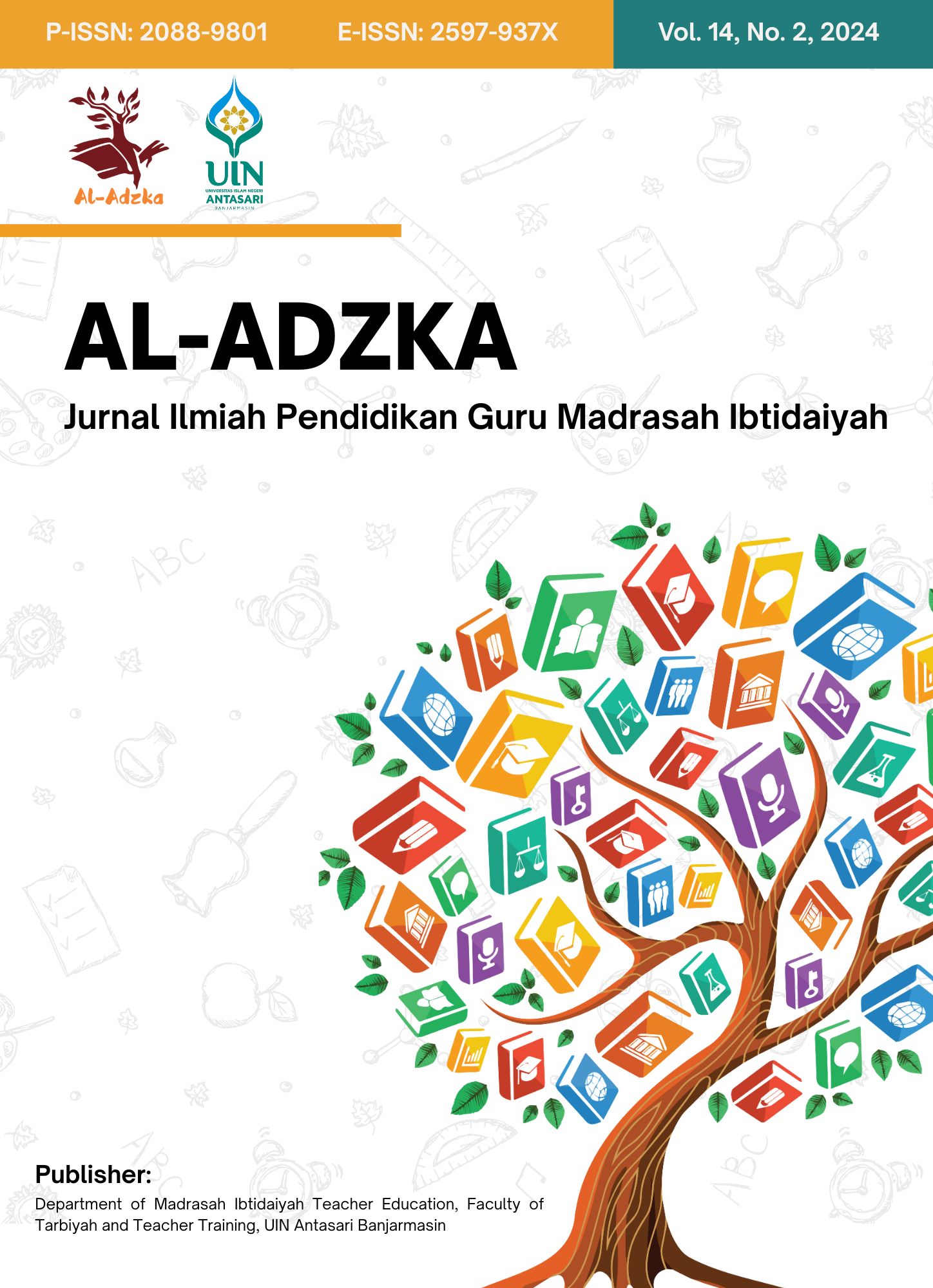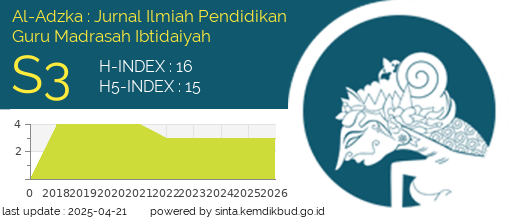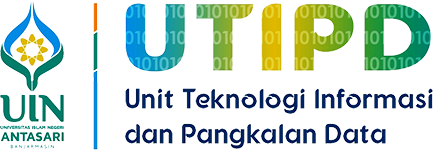Effectiveness of Canva-Based Interactive Animation Media in Enhancing Learning Interest of Second-Grade Madrasah Ibtidaiyah Students
DOI:
https://doi.org/10.18592/aladzkapgmi.v14i2.13896Keywords:
Animation; Canva-Based Interactive; Interactive; Learning InterestAbstract
This research is motivated by the low interest of students in learning the material 'The Word of Invitation and the Word of Refusal', which indicates the need for a method that can be used to improve the learning process. The Word of Invitation and the Word of Refusal' which indicates the need for a more effective learning method. This study aims to analyze the Effect of Canva-based interactive animation media on the interest of 2nd-grade students at Madrasah Ibtidaiyah Masarratul Muta'allimin in Banten Province. A quasi-experimental design involved 56 students divided into experimental and control groups. Student interest data were collected through questionnaires and analyzed using normality, homogeneity, and t-tests. The t-test results indicated a significant difference between the two groups, with a t value of -27.117 (p = 0.000) and an average difference of 19.036. These results suggest that Canva-based interactive media significantly enhances students' interest in learning compared to conventional methods. Canva-based interactive media can effectively increase student engagement. Recommendations for educational practice include integrating interactive media into classroom learning to boost student involvement. Further research is recommended to explore the long-term impact of this media on students' academic performance.References
Al Farisi, F., Syarifuddin, E., & Zuhri, S. (2023). Collaborative leadership in islamic education: communication is the key to successful TQM practices. Tarbawi: Jurnal Keilmuan Manajemen Pendidikan, 9(01), 85–96. https://doi.org/10.32678/tarbawi.v9i01.7970
Alamsyah, A., Dewi, Yuliani, E., Kartika Ramadhan, N., Rosdiah, R., & Sudirman, S. (2023). Efektifitas penggunaan media pembelajaran berbasis canvaterhadap minat belajar siswa di mata pelajaran informatika. Guru Pencerah Semesta, 1(2), 77–87. https://doi.org/10.56983/gps.v1i2.603
Alfajri, M. R., Oktavia, M., & Ayurachmawati, P. (2022). Implementasi media interaktif animasi pada minat belajar materi IPA siswa kelas V. Innovative: Journal Of Social Science Research, 2(1), 308–318. https://doi.org/10.31004/innovative.v2i1.3424
Amalia, R. R., & Suharto, A. W. B. (2024). Reading Guide and Gadget: How to Build Digital Literacy Through Primary Education Student Learning. Al-Adzka: Jurnal Ilmiah Pendidikan Guru Madrasah Ibtidaiyah, 14(1), 43–54. https://doi.org/10.18592/aladzkapgmi.v14i1.12506
Andriyani, A., Dewi, H. I., & Zulfitria, Z. (2020). Penggunaan multimedia dan animasi interaktif terhadap keterampilan membaca permulaan siswa. Instruksional, 1(2), 172. https://doi.org/10.24853/instruksional.1.2.172-180
Ardiansyah, A. (2022). Pengaruh minat belajar terhadap kepuasaan belajar peserta didik dengan media pembelajaran online sebagai variabel moderating. Jurnal Basicedu, 6(1), 1169–1176. https://doi.org/10.31004/basicedu.v6i1.2080
Asmayani, A., Nasrah, N., & Magfirah, N. (2023). Pengaruh media interaktif animasi terhadap minat belajar siswa pada mata pelajaran IPA siswa kelas V UPT SPF SD Negeri Kalukuang II Makassar. Journal on Education, 6(1), 1269–1276. https://doi.org/10.31004/joe.v6i1.3079
Bandura, A. (2018). Toward a psychology of human agency: Pathways and reflections. Perspectives on Psychological Science, 13(2), 130–136. https://doi.org/10.1177/1745691617699280
Baylen, D. M., Gratch, J., & Haynes, L. (2021). Multimedia: Moving beyond passive to active learner engagement. In The Learner-Centered Instructional Designer (pp. 164–175). Routledge.
Clark, R. C., & Mayer, R. E. (2023). E-learning and the science of instruction: Proven guidelines for consumers and designers of multimedia learning. John Wiley & sons.
Creswell, J. W., & Creswell, J. D. (2017). Research design: Qualitative, quantitative, and mixed methods approaches. Sage publications.
Dalimunthe, C. N. A., & Reinita, R. (2022). Validity canva video media integrated thematic learning based on PBL models in elementary schools. Jurnal Gentala Pendidikan Dasar, 7(1), 132–160. https://doi.org/10.22437/gentala.v7i1.18346
Deci, E. L., & Ryan, R. M. (2016). Optimizing students’ motivation in the era of testing and pressure: A self-determination theory perspective. In W. C. Liu, J. C. K. Wang, & R. M. Ryan (Eds.), Building Autonomous Learners (pp. 9–29). Springer Singapore. https://doi.org/10.1007/978-981-287-630-0_2
Ernawati, M. D. W., Sudarmin, S., Asrial, A., Haryanto, H., Sanova, A., Kurniawan, D. A., & Azzahra, M. Z. (2022). The influence of student interest on student learning outcomes in science subjects. Jurnal Pendidikan Sains Indonesia (Indonesian Journal of Science Education), 10(4), 849–861. https://doi.org/10.24815/jpsi.v10i4.25306
Fonseca, D., & García-Peñalvo, F. J. (2019). Interactive and collaborative technological ecosystems for improving academic motivation and engagement. Universal Access in the Information Society, 18(3), 423–430. https://doi.org/10.1007/S10209-019-00669-8
Ghofur, A., & Youhanita, E. (2020). Interactive media development to improve student motivation. IJECA (International Journal of Education and Curriculum Application), 3(1), 1–6. https://doi.org/10.31764/IJECA.V3I1.2026
Giorgdze, M., & Dgebuadze, M. (2017). Interactive teaching methods: Challenges and perspectives. International E-Journal of Advances in Education, 3(9), 544–548. https://doi.org/10.18768/IJAEDU.370419
Hampel, R., & Pleines, C. (2013). Fostering student interaction and engagement in a virtual learning environment: An investigation into activity design and implementation. Calico Journal, 30(3), 342–370. https://doi.org/10.11139/CJ.30.3.342-370
Harackiewicz, J. M., Smith, J. L., & Priniski, S. J. (2016). Interest matters: The importance of promoting interest in education. Policy Insights from the Behavioral and Brain Sciences, 3(2), 220–227. https://doi.org/10.1177/2372732216655542
Helingo, S., Rahim, M., Husain, R. I., & Husain, R. (2023). Canva-based interactive media to increase students’ interest in learning class V State primary school 19 Dulupi. Global Scientific Review, 22, 73–87.
Hilmiyati, F., Nafsi, A. G., & Sabri, S. (2024). The development of canva-based animated videos to improve critical thinking skills of elementary/Islamic elementary school students in science classes on human digestive system materials. Al-Aulad: Journal of Islamic Primary Education, 7(1), 27–37. https://doi.org/10.15575/al-aulad.v7i1.28770
Ilyas, M., Hermawati Syarif, & Refnaldi. (2023). The use of english language learning videos designed through canva app: students’ perceptions. International Journal of Interactive Mobile Technologies (iJIM), 17(08), 100–112. https://doi.org/10.3991/ijim.v17i08.39215
Jariyah, A., Puspitaningtyas, A. R., & Husein, Ach. M. (2024). Pengaruh media interaktif animasi terhadap minat belajar pada mata pelajaran IPA siswa kelas IV di SDN 1 Tribungan Kecamatan Mlandingan tahun akademik 2022/2023. Cendekia Pendidikan, 3(1), 9. https://doi.org/10.36841/cendekiapendidikan.v3i1.4116
Jeno, L. M., Adachi, P. J. C., Grytnes, J., Vandvik, V., & Deci, E. L. (2019). The effects of m‐learning on motivation, achievement and well‐being: A self‐determination theory approach. British Journal of Educational Technology, 50(2), 669–683. https://doi.org/10.1111/bjet.12657
Juhji, J., Jannah, M., & Saefurohman, A. (2022). Development of holistic-based science learning videos: An effort to improve affective skills of madrasah ibtidaiyah students. Jurnal Tarbiyah, 29(2), 325–339. http://dx.doi.org/10.30829/tar.v29i2.1847
Junita, S., Zaini, Z. A. H., Muhith, A., & Ghani, M. F. A. (2024). Implementation of the Trilogy concept: Improving student quality and education standards at the Islamic education foundation. Tarbawi: Jurnal Keilmuan Manajemen Pendidikan, 10(01), 63–76. https://doi.org/10.32678/tarbawi.v10i02.9507
Kim, J., Ham, Y., & Lee, S.-S. (2024). Differences in student-AI interaction process on a drawing task: Focusing on students’ attitude towards AI and the level of drawing skills. Australasian Journal of Educational Technology. https://doi.org/10.14742/ajet.8859
Kinaya, A., Ari Suriani, & Sahrun Nisa. (2024). Pengaruh media interaktif animasi terhadap minat belajar pada mata pelajaran IPA di sekolah dasar. Journal of Practice Learning and Educational Development, 4(2), 88–94. https://doi.org/10.58737/jpled.v4i2.281
Kirschner, P. A., & Van Merriënboer, J. J. G. (2013). Do learners really know best? Urban legends in education. Educational Psychologist, 48(3), 169–183. https://doi.org/10.1080/00461520.2013.804395
Kolås, L. (2015). Application of interactive videos in education. 2015 International Conference on Information Technology Based Higher Education and Training (ITHET), 1–6. https://doi.org/10.1109/ITHET.2015.7218037
Kruger, J.-L., & Doherty, S. (2016). Measuring cognitive load in the presence of educational video: Towards a multimodal methodology. Australasian Journal of Educational Technology, 32(6). https://doi.org/10.14742/ajet.3084
Lestari, N., & Wirasty, R. (2019). Pemanfaatan multimedia dalam media pembelajaran interaktif untuk meningkatkan minat belajar siswa. Amaliah: Jurnal Pengabdian Kepada Masyarakat, 3(2), 349–353. https://doi.org/10.32696/ajpkm.v3i2.289
Lin, M.-H., Chen, H.-C., & Liu, K.-S. (2017). A study of the effects of digital learning on learning motivation and learning outcome. Eurasia Journal of Mathematics, Science and Technology Education, 13(7), 3553–3564. https://doi.org/10.12973/eurasia.2017.00744a
Lukita, H., Sujana, Y., & Budiyanto, C. (2017). Can interactive learning improve learning experience? A systematic review of the literature. International Conference on Teacher Training and Education 2017 (ICTTE 2017), 495–500. https://doi.org/10.2991/ICTTE-17.2017.56
Mayer, R. E. (2005). In Cognitive theory of multimedia learning. Cambridge University Press.
Mayer, R. E. (2022). The future of multimedia learning. The Journal of Applied Instructional Design, 11(4), 69–77. https://doi.org/10.59668/423.10349
Menacho–Vargas, I., Rojas, M. L. R., García, U. C., Aybar, H. N. C., & Washington, D. S. (2022). Canva and collaborative learning in virtual environments with students from the private universities of lima-peru. NeuroQuantology, 20(5), 626. https://doi.org/10.14704/nq.2022.20.5.nq22217
Mou, Z., & Damhuri, D. (2023). The Effect of interactive video learning media on the motivation of arabic language learning of class VIII students of MTs Al-Khairat Paguyaman. Al-Kalim: Jurnal Pendidikan Bahasa Arab dan Kebahasaaraban, 2(1), 14–28. https://doi.org/10.60040/jak.v2i1.15
Mukaromah, N. H., Fuadi, A., & Daryono, R. W. (2024). Assessing the impact of principal leadership and teacher performance on educational quality: The role of TQM as a mediator. Tarbawi: Jurnal Keilmuan Manajemen Pendidikan, 10(01), 145–160. https://doi.org/10.32678/tarbawi.v10i01.9991
Napitupulu, F. H. S. (2021). Pengembangan media video animasi berrbasis powtoon terhadap minat belajar matematika siswa kelas IV SD Negeri 102019 Firdaus. Education Achievement: Journal of Science and Research, 10–20. https://doi.org/10.51178/jsr.v2i1.332
Nicolaou, C., Matsiola, M., & Kalliris, G. (2019). Technology-enhanced learning and teaching methodologies through audiovisual media. Education Sciences, 9(3), 196. https://doi.org/10.3390/educsci9030196
Nuralyanti, P. (2023). Revitalisasi pembelajaran: Solusi terhadap rendahnya minat belajar peserta didik kelas V SDN Sumber Agung. Didaktik: Jurnal Ilmiah PGSD STKIP Subang, 9(5), 2406-2418. https://doi.org/10.36989/didaktik.v9i5.2207
Nurmayuli, N. (2023). Development of an Islamic education management philosophy e-module through the canva application. Tarbawi: Jurnal Keilmuan Manajemen Pendidikan, 9(01), 97–108. https://doi.org/10.32678/tarbawi.v9i01.7963
Nurpiani, R., Anggraeni, S. R., & Farhurohman, O. (2024). Penggunaan media canva untuk meningkatkan minat belajar siswa kelas III sekolah dasar. Al-Madrasah: Jurnal Ilmiah Pendidikan Madrasah Ibtidaiyah, 8(3), 1172–1180. http://dx.doi.org/10.35931/am.v8i3.3561
Ploetzner, R., Berney, S., & Bétrancourt, M. (2020). A review of learning demands in instructional animations: The educational effectiveness of animations unfolds if the features of change need to be learned. Journal of Computer Assisted Learning, 36(6), 838–860. https://doi.org/10.1111/jcal.12476
Pramono, A., Tama, T. J. L., & Waluyo, T. (2021). Analisis arus tiga fasa daya 197 KVA dengan menggunakan metode uji normalitas Kolmogorov-smirnov. Jurnal RESISTOR (Rekayasa Sistem Komputer), 4(2), 213–216. https://doi.org/10.31598/jurnalresistor.v4i2.696
Prasong, F., Kalang, F., & Nurlailah. (2022). Pengembangan media video animasi interaktif untuk meningkatkan minat membaca dengan tema kegemaranku pada siswa kelas 1 MIS Al-Fitrah Oesapa. Jurnal Pendidikan Dasar Flobamorata, 3(1), 276–280. https://doi.org/10.51494/jpdf.v3i1.665
Pulungan, A., Harumy, T. H. F., Manik, F. Y., Ginting, D. S. B., Purnamasari, F., Selvida, D., Nababan, A. M., Nasution, U. R. P., & Nuzuliati, N. (2022). Pembuatan media pembelajaran interaktif canva bersama guru Yayasan Harum Sentosa sebagai upaya meningkatkan minat belajar siswa. Jurnal Pengabdian Kepada Masyarakat Nusantara, 3(2), 483–488. https://doi.org/10.55338/jpkmn.v3i2.372
Purba, Y. A., & Harahap, A. (2022). Pemanfaatan aplikasi canva sebagai media pembelajaran matematika di SMPN 1 NA IX-X Aek Kota Batu. Jurnal Cendekia : Jurnal Pendidikan Matematika, 6(2), 1325–1334. https://doi.org/10.31004/cendekia.v6i2.1335
Ramdani, N. S., Nugraha, H., & Hadiapurwa, A. (2021). Potensi pemanfaatan media sosial tiktok sebagai media pembelajaran dalam pembelajaran daring. Akademika, 10(02), 425–436. https://doi.org/10.34005/akademika.v10i02.1406
Renaldi, D., Edy, Pataropura, A., Subhana, M., Edward Edison, Andrian Febri Handoko, Rafael Ferdianto, & Matthew L.F. Korompis. (2024). Implementasi media pembelajaran menggunakan canva bagi guru sekolah. Abdi Dharma, 4(1), 53–62. https://doi.org/10.31253/ad.v4i1.2783
Sari, H. R., & Yatri, I. (2023). Video animasi melalui aplikasi canva untuk meningkatkan minat belajar bahasa Indonesia siswa sekolah dasar. Edukasiana: Jurnal Inovasi Pendidikan, 2(3), 159–166. https://doi.org/10.56916/ejip.v2i3.381
Sari, N. R. (2018). Animation media to improve student learning results. Jurnal Tadris Matematika, 1(2), 145–156. https://doi.org/10.21274/jtm.2018.1.2.145-156
Shabiralyani, G., Hasan, K. S., Hamad, N., & Iqbal, N. (2015). Impact of visual aids in enhancing the learning process case research: District Dera Ghazi Khan. Journal of Education and Practice, 6(19), 226–233.
Soidik, A., Solichin, E., & Safitri, E. (2020). Perbedaan metode pembelajaran kooperatif tipe problem based learning dengan metode konvensional terhadap hasil belajar IPS terpadu kelas XII SMK Negeri 10 Merangin. Jurnal Muara Pendidikan, 5(1), 602–608. https://doi.org/10.52060/mp.v5i1.276
Solas, E., & Sutton, F. (2018). Incorporating digital technology in the general education classroom. Research in Social Sciences and Technology, 3(1), 1–15. https://doi.org/10.46303/RESSAT.03.01.1
Sunami, M. A., & Aslam, A. (2021). Pengaruh penggunaan media pembelajaran video animasi berbasis zoom meeting terhadap minat dan hasil belajar IPA siswa sekolah dasar. Jurnal Basicedu, 5(4), 1940–1945. https://doi.org/10.31004/basicedu.v5i4.1129
Susanti, S., Putu Ida Arsani Dewi, Nanda Saputra, Atika Kumala Dewi, Fajar Wulandari, Retno Novitasari Kusumawardan, Ihwan Rahman Bahtiar, & Makherus Sholeh. (2022). Desain Media Pembelajaran SD/MI. Yayasan Penerbit Muhammad Zaini.
Susila, H., Muslim, S., & Syahrial, Z. (2019). Interactive multimedia to enhance students’ engagement. Proceedings of the International Conference of Science and Technology for the Internet of Things. International Conference of Science and Technology for the Internet of Things, Yogyakarta, Indonesia. http://dx.doi.org/10.4108/eai.19-10-2018.2281286
Sutarman, S., Edi Hermawan, H., & Ahmad, A. (2017). Character education to build personal learners tough. IOSR Journal of Research & Method in Education (IOSRJRME), 7(1), 59–63. https://doi.org/10.9790/7388-0701055963
Sweller, J. (2020). Cognitive load theory and educational technology. Educational Technology Research and Development, 68(1), 1–16. https://doi.org/10.1007/s11423-019-09701-3
Triarisanti, R., & Purnawarman, P. (2019). The influence of interest and motivation on college students’language and art appreciation learning outcomes. International Journal of Education, 11(2), 130–135. https://doi.org/10.17509/ije.v11i2.14745
Utami, S., Jayanti, J., & Selegi, S. F. (2023). Pengaruh media pembelajaran interaktif animasi terhadap minat belajar pada mata pelajaran IPS di SD Negeri 3 Tanjung Lago. JPDI (Jurnal Pendidikan Dasar Indonesia), 8(1), 21. https://doi.org/10.26737/jpdi.v8i1.3758
Uyun, M., Bahriah, Y., & Fitriani, F. (2022). Interest and learning motivation with student participation. Psikoislamedia: Jurnal Psikologi, 7(2), 119–133. https://doi.org/10.22373/psikoislamedia.v7i2.13794
Virdi, S., Khotimah, H., & Dewi, S. (2023). Sosiologi pendidikan dalam pembentukan karakter peserta didik di sekolah. Protasis: Jurnal Bahasa, Sastra, Budaya, Dan Pengajarannya, 2(1), 162–177. https://doi.org/10.55606/protasis.v2i1.86
Wahyudi, W. (2022). Metode penelitian kuantitatif dan kualitatif. CV. Tohar Media.
Wardana, A., Ramadhan, M. R., Aznur, M., Putri, R. A., & Ikhwan, A. (2023). Media pembelajaran multimedia interaktif menggunakan metode MDLC pada zoom meetings. Jurnal Penelitian Dan Pengkajian Ilmiah Eksakta, 2(1), 25–29. https://doi.org/10.47233/jppie.v2i1.677
Waruwu, A., B., C., & Sitinjak, D. (2022). Penggunaan multimedia interaktif dalam meningkatkan minat belajar siswa pada pembelajaran kimia. Jurnal Pendidikan MIPA, 12(2), 298–305. https://doi.org/10.37630/jpm.v12i2.589
Wibowo, H. S. (2023). Pengembangan teknologi media pembelajaran: merancang pengalaman pembelajaran yang inovatif dan efektif. Tiram Media.
Wibowo, T., Johansyah, R., & Astrina, V. (2022). Efektifitas aplikasi canva untuk meningkatkan motivasi belajar siswa masa kini. J-Simbol: Jurnal Magister Pendidikan Bahasa Dan Sastra Indonesia, 10(2 Sep). https://doi.org/10.23960/j-simbol/v10i2.2022.08
Widayanti, I., & Juhji, J. (2023). Developing STEM-based powtoon animation videos to enhance critical thinking skills in elementary school students. Journal of Integrated Elementary Education, 3(2), 98–108. https://doi.org/10.21580/jieed.v3i2.17483
Widiarti, M., Laksono, K., & Amri, M. (2024). Penggunaan dampak positif terhadap eksplorasi kreativitas literasi digital painting canva pembelajaran puisi kelas 5 SDN Gondek. Cetta: Jurnal Ilmu Pendidikan, 7(1), 14–21. https://doi.org/10.37329/cetta.v7i1.2965
Wulandari, D., Risdianto, E., & Setiawan, I. (2022). Development of E-module materials of quantities and units using canva to increase students’ interest in learning. JENTIK: Jurnal Pendidikan Teknologi Informasi Dan Komunikasi, 1(1), 25–34. https://doi.org/10.58723/jentik.v1i1.27
Yuniarti, A., Titin, T., Safarini, F., Rahmadia, I., & Putri, S. (2023). Media konvensional dan media digital dalam pembelajaran. Jutech : Journal Education and Technology, 4(2), 84–95. https://doi.org/10.31932/jutech.v4i2.2920
Zenki-Dalipi, A., & Osmani, R. (2022). The positive influence of images and graphics presentations in teaching texts for keeping students’attention and concentration. Knowledge-International Journal, 54(5), 751–756. https://doi.org/10.35120/kij5405751z
Downloads
Published
How to Cite
Issue
Section
License
Copyright (c) 2024 Raudhatul Fitriyah, Fitri Hilmiyati, Juhji Juhji

This work is licensed under a Creative Commons Attribution 4.0 International License.
Authors who publish with this journal agree to the following terms:
- Authors retain copyright and grant the journal right of first publication with the work simultaneously licensed under a Creative Commons Attribution 4.0 International that allows others to share the work with an acknowledgement of the work's authorship and initial publication in this journal.
- Authors are able to enter into separate, additional contractual arrangements for the non-exclusive distribution of the journal's published version of the work (e.g., post it to an institutional repository or publish it in a book), with an acknowledgement of its initial publication in this journal.
- Authors are permitted and encouraged to post their work online (e.g., in institutional repositories or on their website) prior to and during the submission process, as it can lead to productive exchanges, as well as earlier and greater citation of published work.












